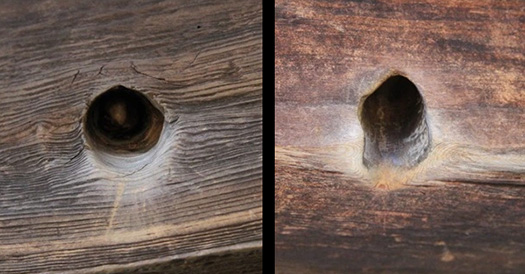



写真は根来寺の国宝「大塔」と江戸期に描かれた境内地絵地図。
周囲が河で2重に囲まれて、城郭としての機能構造が明確に伝わってくる。
宗教は精神性を基盤にするけれど現実的には僧兵による武権として機能した。
Wikipediaの「紀州征伐」の項を参照すると以下のような記述。
「ルイス・フロイスによると16世紀後半の紀伊は仏教への信仰が強く、
4つか5つの宗教が「大いなる共和国的存在」でありいかなる戦争によっても
滅ぼされることはなかった。それらのいわば宗教共和国についてフロイスは
高野山、粉河寺、根来寺、雑賀衆の名を挙げている。フロイスは言及していないが、
五つめの共和国は熊野三山と思える。共和国と表現のこれら寺社勢力や惣国一揆は
高い経済力と軍事力を擁して地域自治を行い、室町時代中期の時点でも
守護畠山氏の紀伊支配は寺社勢力の協力なしには成り立たない状況だった」。
さらに追記されていて「治外法権の地、境内都市」と題して以下の記述。
〜中世において寺領は朝廷も幕府も無断で立ち入ることができない聖域だった。
寺院内部への政治権力による警察権は認められず(検断不入または守護不入)
たとえ謀反人の捜査といえども例外ではなかった。軍事力による介入など許されない。
また寺領内では政府の徴税権も及ばなかった(諸役不入)。このような世間に対する
別天地である寺院の境内は苦境の人々の避難所(アジール)の性格を持つようになる。
一度寺に駆け込めば外での事情は一切問われない。犯罪者ですら例外ではなかった。
境内は貧富貴賎さまざまな人々が流入し、当時の寺社の文化的先進性と結びついて
都市的な発展を遂げる。有力寺社は京都など政治中枢から遠くない場所にあり、
政治的中立、軍事的不可侵に守られ商工業金融の拠点として強い経済力を持った。
これを「境内都市」という。高野山や根来寺は、典型的な境内都市である。〜

写真上は国宝の根来寺「大塔」に残されている戦国期の「銃弾痕跡」。
経緯から見て秀吉の紀州征伐のときの戦闘痕跡と思われます。
こういった権力構造が支配的な地域が紀州ということであり、
そのときどきの中央権力も手を焼く地域だったけれど、信長・秀吉の政権は
このような宗教権力の跋扈を許さず、武力制圧を行った。
根来寺は、秀吉の「紀州征伐」によっていったん壊滅させられるのです。
歴史を知るほどに宗教と軍事は密接に結びついている実態を知ることができる。
とくに紀州は海運が盛んで鉄砲火薬の生産・流通に深く関わって
商業への支配が強い寺社勢力は容易に武装できたということなのでしょう。
中世社会とはこうした「既得権益層」同士の争闘の歴史とも見える。
宗教というキレイ事を唱える分、武家よりも業が深いのではとも思えてきます。
English version⬇
[Sengoku Kishu explores the religious oligopoly "Negoroji" -2]
The photo is a map of the precincts drawn in the Edo period with the national treasure "Oto" of Negoroji Temple.
Surrounded by rivers, the functional structure of the castle is clearly conveyed.
Although religion is based on spirituality, it actually functioned as a military power by monks.
If you refer to the section of "Battle of Kishuu" on Wikipedia, the description is as follows.
"According to Luis Frois, Kii in the latter half of the 16th century had a strong belief in Buddhism.
Four or five religions are "great republican beings" and by any war
It was never destroyed. Frois about those so-called religious republics
He names Koyasan, Kokawaji, Negoroji, and Saika Ikki. Frois doesn't mention it,
The fifth republic seems to be Kumanosanzan. These temples and shrines of republic and expression and Sokoku Ichigo
It has high economic power and military power to carry out regional autonomy, even at the time of the middle of the Muromachi period.
Mr. Hatakeyama's rule of Kii would not have been possible without the cooperation of the temples and shrines. "
Further added is the following description entitled "Land of extraterritoriality, precinct city".
~ In the Middle Ages, the temple territory was a sanctuary where neither the imperial court nor the shogunate could enter without permission.
Police power by political power inside the temple is not recognized (non-inspection or non-protection)
Even the investigation of rebels was no exception. Intervention by military force is not allowed.
In addition, the government's right to collect taxes did not extend to the temple territory (no roles). For such a world
The precincts of the temple, which is a different place, will have the character of a shelter (Azir) for people in distress.
Once you rush to the temple, you don't have to worry about the situation outside. Even criminals were no exception.
Various people, rich and poor, flowed into the precincts, and it was linked to the cultural advancement of the temples and shrines at that time.
Achieve urban development. Although many leading temples and shrines are not far from the political center such as Kyoto,
Protected by political neutrality and military inviolability, it has gained strong economic power as a base for commerce, industry and finance.
This is called a "precinct city". Koyasan and Negoroji are typical precinct cities. "
On the photo is the "Ammunition Trace" of the Warring States period left at the national treasure Negoroji Temple "Oto".
From the background, it seems to be a battle trace when Hideyoshi conquered Kishu.
Kishu is the area where such a power structure is dominant.
At that time, the central power was also a difficult area, but Nobunaga and Hideyoshi's administration
He did not allow such religious power to be dismissed, and suppressed armed forces.
Negoroji is once destroyed by Hideyoshi's "Battle of Kishuu".
The more we know the history, the more we can know the reality that religion and military are closely linked.
Especially in Kishu, shipping is thriving and deeply involved in the production and distribution of gunpowder.
It seems that the temples and shrines with strong control over commerce could easily be armed.
The medieval society can be seen as the history of the struggle between these "vested interests".
It seems that the work is deeper than the samurai family because it advocates the beauty of religion.



















